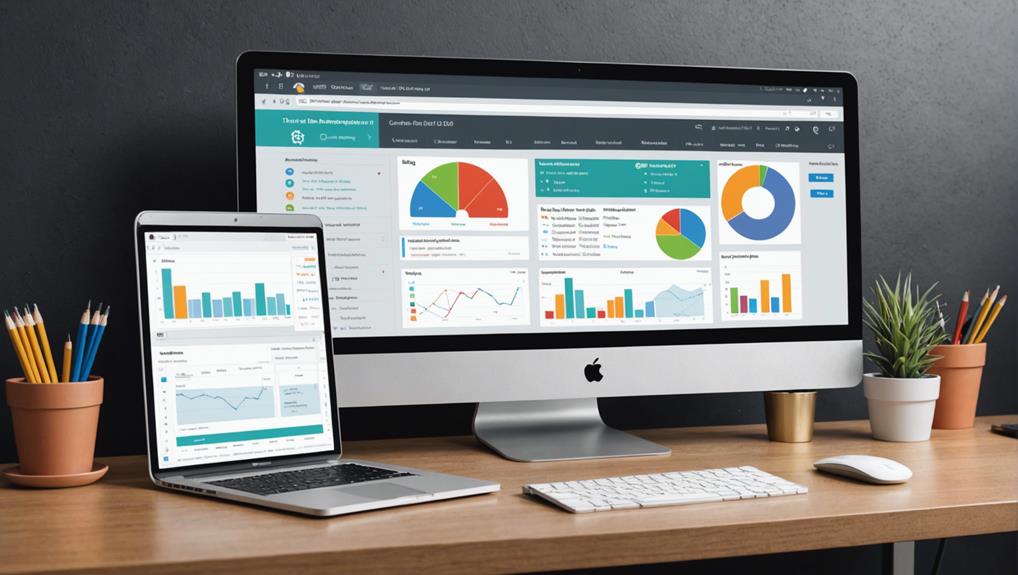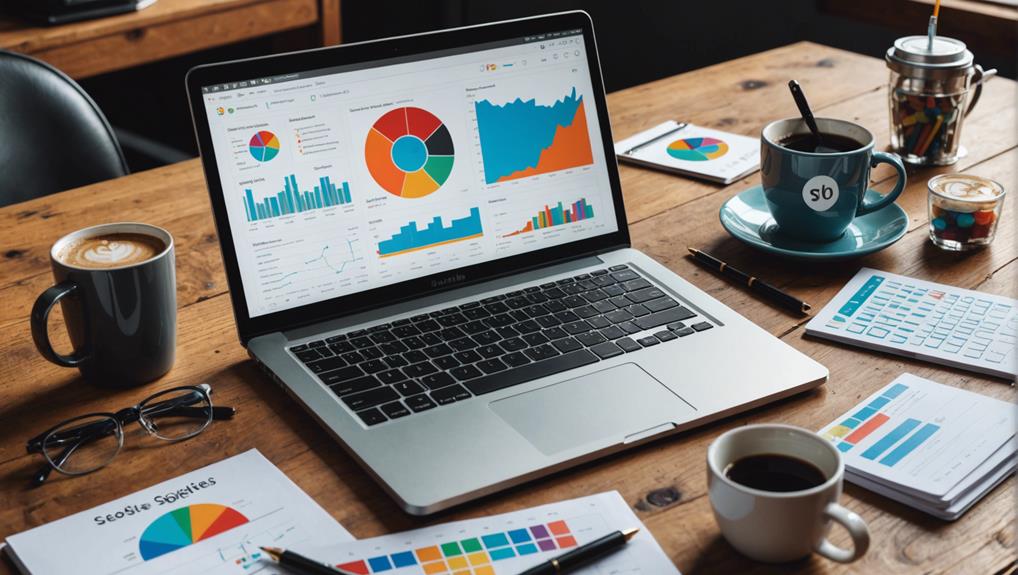To boost SEO with internal linking, first establish a clear website hierarchy and guarantee logical navigation. Use keyword-rich anchor text and link from high-traffic pillar pages to relevant content. This strategy improves user experience, distributes link authority, and helps search engines understand your site structure. Regularly audit your internal links to maintain an effective hierarchy and optimize engagement. Tools like Ahrefs and SEMrush can assist in analyzing link equity and tracking orphaned pages. Prioritizing contextual and navigational links enhances SEO performance further. Follow these steps, and you'll uncover more insights into maximizing your SEO strategy.
Key Takeaways
- Distribute link authority by linking lower-level pages to higher-level, authoritative pages for enhanced rankings.
- Use descriptive anchor text with relevant keywords to improve search engine context and user experience.
- Create a logical content hierarchy with well-organized internal links to enhance crawlability and site navigation.
- Embed contextual links within content to provide valuable context and guide search engine crawlers.
- Regularly audit and optimize internal links using tools like Ahrefs, SEMrush, and Moz for maximum SEO benefits.
What Are Internal Links?
Internal links are hyperlinks that direct users to different pages within the same website, playing an important role in SEO strategies. By establishing website hierarchy and improving navigation, internal links help search engines understand the relationships between various pages. This understanding is vital for implementing effective internal linking strategies that can greatly enhance your site's SEO benefits.
When you utilize internal linking strategies, you're not just enhancing search engine crawlers' ability to index your content; you're also distributing link authority throughout your site. This distribution helps guarantee that important pages receive the necessary link juice, thereby improving their chances of ranking higher in search engine results. Additionally, internal links guide visitors to related content, enhancing user engagement and reducing bounce rates.
For instance, if a visitor lands on a blog post about 'keyword research,' an internal link to another post on 'SEO tools' can keep them engaged longer, signaling to search engines that your content is valuable and relevant. Proper internal linking strategies thus create a seamless user experience while amplifying your site's SEO benefits.
Benefits of Internal Linking
Enhancing your SEO strategy through internal linking offers multiple benefits, including improved user experience, better navigation, and increased page authority.
By implementing effective internal linking strategies, you can create a more cohesive website, establishing clear relationships between your content. This helps users find relevant information easily and intuitively, reducing bounce rates and increasing engagement.
Internal linking doesn't just benefit users; it also provides significant SEO benefits. Distributing link authority among your pages boosts the SEO performance of individual pages, making them more likely to rank higher in search results. Properly placed internal links guide search engine crawlers to your most important content, ensuring these pages get indexed and gain visibility.
Moreover, contextual internal links offer search engines valuable context about the importance and relevance of your linked pages. This can lead to better keyword ranking and improved overall site authority.
Internal Vs. External Links
While internal links enhance your site's navigation and SEO, understanding the role of external links is equally important for a well-rounded SEO strategy. Internal link building connects pages within your domain, establishing an information hierarchy that improves user experience. By strategically placing internal links, you can guarantee efficient link juice distribution, directing SEO value to key pages and bolstering their ranking potential.
Conversely, external links point to pages on other websites and play a crucial role in your off-page SEO strategies. They contribute to building a robust backlink profile, which search engines consider when evaluating your domain authority. High-quality external links can enhance your credibility and visibility, driving more traffic to your site.
However, don't underestimate the power of internal link building. It not only aids in link juice distribution but also keeps users engaged by guiding them to related content on your site. This reduces bounce rates and increases the time users spend on your pages—essential factors that search engines use to rank websites.
Creating an Effective Site Structure
To establish an effective site structure, begin by organizing your content hierarchically to enhance crawlability and user navigation. Make sure your URL structure is logical and reflective of your content hierarchy, facilitating search engines to index your pages.
Consistent navigation menus will further improve user experience and distribute link equity effectively across your site.
Hierarchical Content Organization
Your website's hierarchical content organization is essential for ensuring search engines understand the importance and relevance of each page. By structuring your content hierarchy logically, you can boost your SEO efforts significantly. This involves creating an effective site structure, which not only helps search engines but also enhances user experience.
A well-planned content hierarchy distributes link equity more effectively, making sure that your most important pages receive the necessary link authority. This can lead to improved search engine rankings and increased organic traffic.
Here's how to do it:
- Categorize Content: Organize your pages into categories and subcategories based on relevance. This makes it easier for search engines to crawl and index your site.
- Strategic Internal Linking: Use internal links to connect related content. This helps distribute link equity and signals to search engines which pages are most important.
- Use Breadcrumbs: Implement breadcrumb navigation to guide users through your content hierarchy. This not only improves user experience but also helps search engines understand your site's structure.
Logical URL Structure
A crucial URL structure is essential for enhancing both user experience and SEO performance by making your website easier to navigate and understand. When you categorize pages into clear sections, you create a logical flow that helps users and search engines alike. This site architecture aids in URL optimization, making your SEO strategy more effective.
Search engines rely heavily on the structure of your URLs to understand the hierarchy of your content. By organizing URLs hierarchically, you improve the crawlability and indexability of your website, directly impacting your site's SEO performance. For instance, a URL like 'example.com/category/subcategory/page' clearly signals the content hierarchy, making it easier for search engines to index your pages.
Including relevant keywords in your URLs can further boost your SEO strategy. Keywords within URLs offer a clear indication to search engines about the content of each page. This is a straightforward yet powerful way to enhance visibility in search engine results pages (SERPs).
In essence, focusing on a logical URL structure not only improves user experience but also solidifies your site's SEO foundation. It's a data-driven approach that can yield significant advantages in your overall SEO efforts.
Consistent Navigation Menu
Establishing a consistent navigation menu is essential for guiding users and search engines efficiently through your website. A well-thought-out menu design not only enhances user engagement but also guarantees navigation consistency, meeting accessibility standards.
Here's why a structured navigation menu is vital for your SEO:
- Improved User Experience:
A clear and consistent navigation menu helps users easily find and access different sections of your website, reducing confusion and bounce rates. When users can navigate effortlessly, they're more likely to stay longer and explore more pages.
- Enhanced SEO:
Search engines rely on a well-organized menu to crawl and index your site effectively. Internal links within your navigation menu distribute link equity to key pages, improving their chances of ranking higher in search results.
- Accessibility Compliance:
Adhering to accessibility standards in your navigation menu design ensures that users with disabilities can navigate your site without issues. This not only broadens your audience but also positively impacts your SEO, as search engines favor sites that are accessible to all users.
Identifying Pillar Pages
To identify pillar pages, analyze your site's key topics that align with high search volume and relevance to your industry. Start by conducting keyword research to pinpoint terms that are both highly searched and central to your business. These keywords will guide your pillar page strategy, ensuring your content optimization efforts focus on topics that attract substantial traffic.
Next, evaluate your existing content to find detailed, high-quality pieces that already cover broad topics in-depth. These could be the foundation of your pillar pages. A good pillar page not only provides thorough information but also links to related cluster content, establishing a network of interconnected articles. This network helps search engines understand your site's topical authority.
By selecting key topics that resonate with your target audience, you enhance your site's relevance and improve search engine rankings. Use tools like Google Analytics and SEMrush to analyze which topics drive the most engagement and traffic.
Using Contextual Links
Identifying pillar pages sets the stage for leveraging contextual links to enhance your site's SEO and user experience. Contextual linking strategies involve embedding hyperlinks within your content to direct users to related topics on your website. These links help establish the context and relevance of linked pages, boosting their SEO value.
By following effective internal link building techniques, you can strategically place contextual links to improve navigation and increase user engagement. Here's a data-driven approach to implementing these strategies:
- Use Descriptive Anchor Text: Make sure your anchor text is descriptive and relevant to the linked content. This not only enhances user experience but also signals search engines about the content of the linked page.
- Strategically Place Links: Position your contextual links where they naturally fit within the content. This helps maintain a smooth reading flow and encourages users to explore more pages, reducing bounce rates.
- Prioritize High-Value Pages: Link to pages that you want to rank higher in search results. This internal link building technique distributes link equity, making your site's structure more SEO-friendly.
Optimizing your internal linking through these contextual linking strategies can significantly enhance your site's search engine rankings and user engagement.
Linking Hierarchical Pages
Linking hierarchical pages enhances both user navigation and search engine indexing by establishing a clear, structured pathway through your website's content. When you connect pages based on their importance and relevance within the site's architecture, you create a well-defined page hierarchy that benefits both users and search engines.
For example, by linking lower-level pages to higher-level ones, you not only guide visitors to key content but also pass link authority. This transfer of authority can greatly improve the overall SEO of your site. Search engines, in turn, use this hierarchy to better understand your website's organization and rank your content more effectively.
Data shows that websites with a robust internal linking strategy experience improved user engagement and higher search engine rankings. Hierarchical linking promotes content discoverability, ensuring that visitors can easily find the most important pages. This improves the user experience and encourages longer site visits.
To maximize the benefits, regularly audit your internal links to make sure they reflect your site's page hierarchy. By doing so, you maintain a strong site architecture that enhances both usability and SEO performance.
Essentially, proper hierarchical linking is a cornerstone of an effective internal linking strategy.
Building on the foundation of hierarchical linking, integrating navigational links into your website's main menu, sidebar, or footer sections can greatly enhance user experience and SEO performance. Navigational links are essential for guiding users to important pages, making your site easier to navigate and more user-friendly.
To effectively utilize navigational links, consider these three key strategies:
- Optimize Navigational Hierarchy: Guarantee your links follow a logical structure that aligns with your site's content hierarchy. This helps search engines understand the importance of each page and improves crawl efficiency.
- Strategic Link Placement: Position your navigational links in prominent areas such as the main menu, sidebar, and footer. Proper link placement ensures users can easily find what they're looking for, reducing bounce rates and increasing page views.
- Consistent and Clear Labeling: Use clear, descriptive anchor text for your navigational links. This not only enhances usability but also provides search engines with context about the linked pages, boosting your SEO.
Optimizing Anchor Text
Optimizing anchor text by incorporating relevant keywords can greatly enhance your website's SEO performance. Anchor text optimization involves using descriptive, keyword-rich phrases rather than generic terms like 'click here.' By strategically placing keywords within your anchor text, you provide valuable context about the linked page to both users and search engines. This context not only improves user experience but also boosts the link relevance, making it easier for search engines to understand and rank your pages accurately.
Effective SEO strategies should prioritize keyword placement within anchor text to maximize the impact on search engine rankings. Data shows that pages linked with optimized anchor text tend to perform better in search results. For instance, if you're linking to a page about 'organic gardening tips,' using anchor text like 'best organic gardening practices' is far more effective than a generic 'read more.'
Furthermore, it's important to maintain variety in your anchor text while ensuring it remains relevant to the content it links to. Overuse of the same keywords can lead to diminishing returns, and search engines might perceive it as manipulative. Therefore, balance and relevance are key in anchor text optimization for improving your overall SEO strategies.
Auditing Internal Links
Conducting regular audits of your internal links is crucial for guaranteeing they remain functional, relevant, and strategically beneficial for your SEO efforts. Auditing helps you identify broken links, orphaned pages, and suboptimal linking strategies that could undermine your SEO performance. By maintaining high link quality, you'll enhance both user experience and search engine ranking.
To effectively audit your internal links, follow these steps:
- Check for Broken Links: Broken links can frustrate users and negatively impact your SEO. Regularly scan your site to guarantee all links are functional.
- Identify Orphaned Pages: Use tools like Google Search Console to find pages lacking internal links. These pages can be overlooked by search engines, affecting their visibility.
- Assess Link Distribution: Ensure important pages receive adequate link authority. Evaluate your internal linking structure to confirm key pages are prioritized.
Optimizing your internal linking strategies through regular audits guarantees each page maintains appropriate and strategic links. This not only keeps your website's structure robust but also boosts your overall SEO performance. Consistent monitoring and refinement of your link quality will help you stay ahead in the competitive digital landscape.
Tools for Internal Linking
Several powerful tools can greatly enhance your internal linking strategy by providing detailed analysis and actionable recommendations. Tools like Ahrefs, SEMrush, and Moz are essential for identifying broken links, orphaned pages, and opportunities for improvement, all of which are critical for effective internal linking strategies.
These tools offer invaluable insights into link equity distribution, enabling you to optimize your internal linking structures for better SEO performance. They track link clicks, monitor anchor text usage, and improve site navigation, thereby boosting your website's visibility.
Here's a quick comparison of these tools:
| Tool | Key Features | Benefits |
|---|---|---|
| Ahrefs | Internal link analysis, broken link check | Enhances link equity optimization |
| SEMrush | Orphaned pages, anchor text tracking | Improves internal linking strategies |
| Moz | Link equity distribution insights | Boosts site navigation |
Utilizing these tools can streamline your internal linking efforts and make sure you're making the most of your link equity. Their detailed analysis helps you pinpoint weaknesses and capitalize on strengths within your site's structure. By implementing these tools, you'll not only enhance your internal linking strategies but also notably improve your site's SEO performance and visibility.
Frequently Asked Questions
Do Internal Links Improve Seo?
Yes, internal links improve SEO by enhancing user experience and content structure. They help search engines crawl your site more effectively, distribute link equity, and establish contextual relationships, leading to higher rankings and increased organic traffic.
Does Linking Improve Seo?
Yes, linking improves SEO to a great extent. By employing a strategic linking strategy and using descriptive anchor text, you can enhance crawlability, boost page authority, and improve your site's ranking potential, driving more organic traffic and engagement.
Are Too Many Internal Links Bad for Seo?
Yes, too many internal links can harm SEO. Link spamming confuses search engines and diminishes user experience. Stick to Google's recommendation of 100 links per page to guarantee peak crawlability and maintain page value.
How Many Internal Links per Page for Seo?
You should aim for around 100 internal links per page. Guarantee strategic link placement and use relevant anchor text. Exceeding this limit can dilute link equity and reduce each link's effectiveness in distributing authority.
Conclusion
By strategically using internal links, you can greatly enhance your site's SEO. Focus on creating an effective site structure, identifying pillar pages, and using optimized anchor text.
Regularly audit your internal links to make sure they're functioning correctly and enhancing user experience. Utilize tools for internal linking to streamline the process and gather data-driven insights.
Implement these tactics, and you'll see improved search engine rankings and increased organic traffic.




